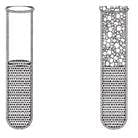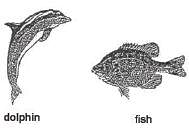Olympiad Test: Living Organisms And Their Surroundings -1 - Class 6 MCQ
20 Questions MCQ Test - Olympiad Test: Living Organisms And Their Surroundings -1
Which among these children made a correct statement?
Which of the following characteristics of a glass of water mean that it cannot be considered alive?
| 1 Crore+ students have signed up on EduRev. Have you? Download the App |
Some yeast, sugar and water are mixed in a test-tube. The diagrams show the testtube at the start and after one hour.

Q. Which process causes this change?

Excretion, irritability and reproduction are characteristics of:
One of the characteristics of living organisms is that they all respire by:
Which of the following organisms is not ultimately dependent on the sun as a source of energy?
Organisms that obtain their food from others are called
Some green beans were placed on some damp cotton wool in a dish and placed in a dark corner. A few days later, the beans started to grow into seedlings. The beans get their food for growth from the ________________.
The common animals found on mountains are
Which of the following describes respiration?
Ananya: Animals take in carbon dioxide and give off oxygen.
Sanchit: Animals take in oxygen and give off carbon dioxide.
Saumya: Plants take in carbon dioxide and give off oxygen.
Ranchit: Plants take in oxygen and give off carbon dioxide.
Which one is a abiotic factor of environment
Animals have structural and behavioural adaptations which enable them to survive in their natural habitats.

Q. By looking at the picture of the head of the fish, which of the following is true of how this organism survives in its natural habitat?
Shape, size and other features of plants depends upon their
The following aquatic animals are grouped according to their breathing adaptations. Which group of animals does not breathe in the same way?
Living creatures of various kind are called
Which of the following animals have the correct form of adaptation?
During photosynthesis which gas is released?
Pines, Deodar and oak are the plants found in/on
Fish absorbs oxygen from water through their
Based on the diagrams of the dolphin and the fish (not drawn to scale), which characteristic they share in common?

1. They both have whiskers.
2. Each has a tail to propel itself forward in the water.
3. Both have gills to breath.
4. Both are warm blooded.

















